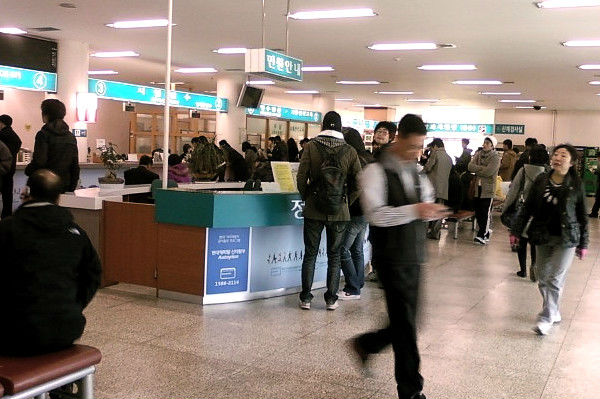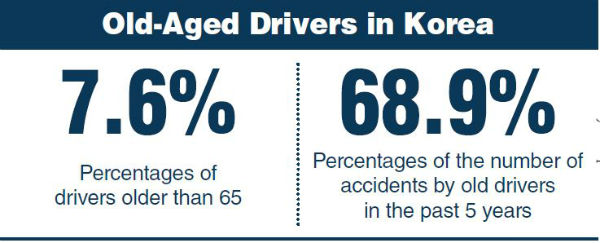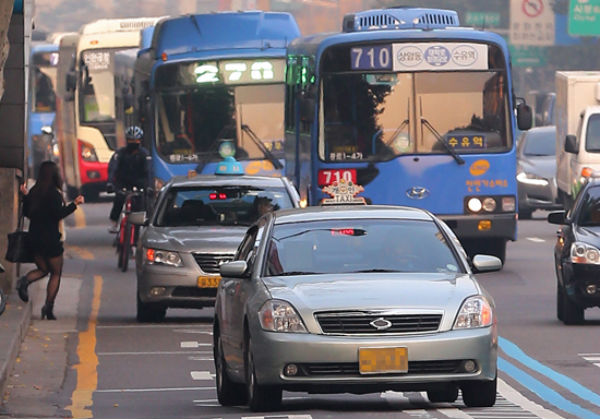It has been confirmed that the perpetrator of a car accident in Haeundae District, which resulted in 17 casualties, had epilepsy, a medical disorder that inhibits one’s driving. What is not understandable is that the driver had been able to obtain and renew his license, despite having such a disorder. This put into question the reliability of the filtering method of the current Korean driver’s license system. The Sungkyun Times (SKT) looks into the loopholes hidden in the current system, and seeks further possible changes while referring to other nations’ systems.
Current Driver’s License System in Korea
In Korea, the process of acquiring a driver’s license has been simplified since six years ago. Anyone willing to obtain a license has to follow through four stages: medical checkup, written exam, driving course test, and on-road driving exam. For medical examinations, only basic tests are conducted, such as color vision tests, and height and weight measures. For the last three stages, the candidate must attend an education seminar to prepare for every examination, for total of 14 hours minimum. With this procedure, theoretically, a candidate can pass all the exams and receive his or her license within two days.
All drivers with a Class 1 driver’s license (a license that permits the holder to drive automobiles with manual and automatic transmissions) must get their licenses reissued every ten years. During this process, drivers need to pass their medical examinations again, but the examination is minimal, only taking 30 minutes at most. In case where a driver has a medical disorder that causes interruptions while driving, they must report it by themselves. Such disorders include mental disorders such as epilepsy (only if hospitalized more than six months), alcohol or drug addictions, and other disabilities that are considered to cause direct or indirect impact on driving. For those who drive heavy vehicles, hearing tests are compulsory, but the tests are simple, as well. Drivers with Class 2 licenses (a license that permits the holder to drive automobiles with automatic transmissions only) do not have to go through the tests when they want to renew their license. In other words, once they acquire a Class 2 driver’s license, they do not need further examination until the age of 65.
Drivers aged 65 years or above need to have their physical checkup every three years to renew their licenses, and Class 2 drivers require the same medical examinations as well. Furthermore, drivers with disorders need to receive a pass by the special committee organized by the Korea Road Traffic Authority (KRTA). The committee looks into the medical records of the candidate and decides whether to renew or to cancel the license, or put off the decision until later. If the decision is put off, the committee revisits the case after a year.

From this November, the difficulty of the driver’s license examinations will be raised. Several critics, however, have pointed out that making the examination harder does not solve the general problem of management. It is true that in the short run, the number of car accidents would decrease, as drivers would take to the road with better skills, but in the long run, there would not be a noticeable change. The recent automobile accidents have proven that the focus should not only be on the difficulty of the examinations, but also on the general management of the drivers themselves, not to mention their health conditions.
Ongoing Issues
Over-Reliance on Individuals
At present, the KRTA is relying heavily on individual drivers upon their own health and mental conditions related to driving. In other words, the KRTA does not have effective methods to gather specific information about a candidate, including the medical conditions of a candidate. The KRTA does receive reports about several drivers with mental disorders, but that is only done when a driver is hospitalized for more than six months. Considering that admittance in a mental hospital for six months is not a usual occurrence, it is hard to verify the possible mental disorders of drivers.
In the current Korean driver’s license system, a candidate has to report his or her disease by oneself. Reporting is usually done by filling a simple medical form, which is just one page. People usually tend not to read all the text carefully, just ticking all the “No” boxes. Not only that, the self-reporting system allows the patients to hide their medical disorders that can hinder driving, and easily acquire or renew their license. This explains how the perpetrator of the car accident at Haeundae was able to renew his license a month before the accident. The perpetrator had a disorder that should prohibit the patient from driving, but he did not inform the KRTA so that he could reissue his license without further checkups.
Meager Driver Management
Another core issue of the Korean driver’s license system is on the management of drivers. As mentioned earlier, renewing a driver’s license in Korea only takes about 30 minutes. There have been criticisms that the current medical examination for renewal has become perfunctory. No specific inspections on any kind of disorders for low-risk people are present. This superficial test for low-risk people is conducted in the same way for drivers over 65, despite the fact that they are at an age in which physical and mental capabilities start to deteriorate. Last year in Korea, about 7.6% of the drivers out of 30 million were over 65. With the increasing number of elderly citizens, the frequency of accidents caused by aged drivers increased by 68.9% in the last five years. Statistics indicate that aged drivers are increasing, and more thorough inspections are needed. The current system, however, treats them as same as drivers in their 20s. The only difference is that aged drivers are tested more often, but still only routinely.
Criticisms have also questioned the validity of the medical tests conducted by the committee formed by the KRTA to examine the suitability of driving in applicants with serious disabilities. First and foremost, the passing rate for these special medical examinations is a little above 97%, ranging from the year 2011 to July, 2015. If comparing this rate with that of Germany, which is at a maximum of 40%, it is possible to infer that the passing rate in Korea is rather high. Furthermore, in 2015, out of the 190 committee members from 26 driving license test centers, only 48 were professional doctors, with all other members from KRTA, or other professionals on road transportation. Having staff members with almost no medical knowledge decide on the passing or failing of a high risk driver is a problem, considering that without proper medical knowledge, they would eventually make the wrong decisions on the validity of drivers to drive. There should be more professional doctors on site to administer the tests for more accurate verification.


Lack of Collaboration
What is surprising is that there is a lack of collaboration between the KRTA and other medical institutions or organizations. The National Health Insurance Service (NHIS), which has the medical records of all the citizens, does not have the responsibility to report any patients to the KRTA or to the police. Even though disorders such as epilepsy are quite serious, the KRTA does not know whether drivers suffer from them because the KRTA does not have the information from the NHIS. If there were information exchange between these institutions, incidents like the Haeundae car accident could have been prevented easily.
At present, the NHIS has not provided such information, because distributing medical records can be considered as an infringement of privacy. It now seems true that there is information that needs to be shared for public safety in general. As of now, the police and the KRTA are already sharing data on drivers, such as car accidents and driver’s license information. Having this relationship ongoing at present, exchange between the KRTA and the NHIS seems more required than ever.
Possible Changes
Other Nations
United Kingdom
The United Kingdom (UK) is one of the nations that puts harsh restrictions on drivers with medical disorders. Just like Korea, epilepsy and addictions are disorders that prohibit drivers from driving in the UK. One of the key differences between the UK and Korea is that the UK considers diabetes as a disease that interferes with driving, because the resulting hypoglycemia can cause shock, temporarily disallowing the driver from controlling themselves. Another difference is that it is compulsory for drivers with disorders to attend specific seminars. For instance, drivers with diabetes in the UK must attend seminars on preventing hypoglycemia.
The renewal of a license in the UK is also stricter than in Korea. For patients with diabetes, the applicants need to be free from hypoglycemia for the past 12 months to renew their licenses. Drivers who take insulin also need to file a report on a yearly basis, and renew their licenses every year. They are also prohibited from driving trucks heavier than 7.5 tons or buses that hold more than nine people. If bus or truck drivers take special medications related to diabetes, then they need to pass driving and medical examinations to keep their licenses.
Japan
Japan is a nation that puts harsh restrictions on aged drivers. Japan has a high percentage of elderly citizens, and there are many aged drivers, too. At present, every single driver over 75 must attend a seminar, pass a medical examination, and receive on-road training when renewing the license.
Another policy that Japan has employed is persuading elderly drivers to return their driving licenses through conciliatory policies. These policies include discounts on hotels and museums, higher deposit rates in banks, and other advantages. With these policies, more than 20,000 aged drivers have been giving up their licenses since 2014.
What About Korea?
It is assumable that the general management system of drivers in Korea is quite loose, if compared with that of other nations. The Korean system needs to change in every aspect. Policies need to change – such as the rule that a driver’s mental disorder to be reported only after six months of hospitalization. Everyone, regardless of license classes, should undergo stricter medical examinations, with more frequent license renewals. Especially for those with particular disorders or old age, they should be persuaded not to drive a car, and have higher boundaries to acquire and renew driver’s license.
This does not mean that people with disorders or old age should be completely banned from driving. First of all, many disorders can be healed or subdued. For instance, epilepsy seizures can be controlled through medication. The car accident at Haeundae took place because the driver had not taken pills for about a month, even though the driver was instructed to take them. It is also possible to monitor the driver continuously, such as disallowing a driver from driving for six months after seizures. Problems also arise when old drivers are forced to retire. In Korea, the majority of bus or taxi drivers are over 65. If they are forced to give up their license, they would find it hard to continue their living. The transportation industry in Korea will suffer from a lack of working forces. Therefore, persuading people to give up the licenses is yet to be applicable in Korea. The best solution would therefore be enforcing the management system of drivers. A balance between satisfying the current situation as well as the future needs to be found. This can only be done through a series of changes in the Korean driver’s license system.
Raising the difficulty level of exams is not the answer in decreasing the number of car accidents. What is important is having a strict management of the driver’s license holders. It is the moment to revise the ongoing system, and make renovations to close the loopholes
